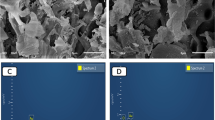Abstract
In the production of liquid hydrogen, trace impurities (nitrogen and methane) must be removed to very low levels (1 ppm) prior to liquefaction to avoid plugging of the heat exchangers. This is generally done by adsorption on activated carbon or silica gel at cryogenic temperatures (−280 to −320°F). The working pressure, which depends on the location in the process where the adsorbers are placed, is generally in the range of 200 to 1000 psia. Two adsorption beds are used with one being regenerated with purified hydrogen, while the other is in the adsorption phase. Regeneration temperatures are on the order of 250 to 300°F at approximately the same pressure as the adsorption pressure.
Access this chapter
Tax calculation will be finalised at checkout
Purchases are for personal use only
Preview
Unable to display preview. Download preview PDF.
Similar content being viewed by others
References
M. J. Hiza, Chem. Eng. Progr. 56(10):68 (1960).
M. J. Hiza and A. J. Kidnay, in Advances in Cryogenic Engineerings, Vol. 6, Plenum Press, Inc., New York (1961), p. 457.
M. J. Hiza and A. J. Kidnay, in Advances in Cryogenic Engineering, Vol. 8, Plenum Press, Inc., New York (1963), p. 174.
A. J. Kidnay and M. J. Hiza, Aiche J. 12(1):58 (1966).
A. J. Kidnay, M. J. Hiza, and P. F. Dickson, in Advances in Cryogenic Engineering, Vol. 13, Plenum Press, Inc., New York (1968), p. 397.
L. C. Eagleton and H. Bliss, Chem. Eng. Progr. 49:543 (1953).
A. J. Kidnay and A. L. Meyers, Aiche J. 12:981 (1966).
W. H. Cook, Ph.D. Dissertation, University of Ottawa, Ottawa, Canada (1965).
D. M. Young and A. D. Crowell, Physical Adsorption of Gases, Butterworths, London (1962).
M. M. Dubinin and E. D. Zaverina, Acta Physicochim U.R.S.S. 4:67 (1936).
M. M. Dubinin, Chem. Rev. 60:235 (1960).
W. K. Lewis, E. R. Gilliand, B. Chertow, and W. P. Cadogan, Ind. Eng. Chem. 42:1326 (1950).
J. W. Haaz and C. A. Barrere, Jr., Chem. Eng. Progr. Symp. Ser. 65(96):48 (1969).
A. J. Kidnay and M. J. Hiza, in Advances in Cryogenic Engineering, Vol. 12, Plenum Press, Inc., New York (1967), p. 730.
F. D. Maslan, M. Altman, and E. R. Aberth, J. Phys. Chem. 57:106 (1953).
W. H. Cook and D. Basmadjian, Can. J. Chem. Eng. 42:146 (1964).
Pittsburgh Carbon Company, Division of Calgon.
I. Zwiebel, R. L. Gariepy, and J. J. Schnitzer, Aiche J. 18(6): 1139 (1972).
I. Zwiebel, C. M. Kralik, and J. J. Schnitzer, Aiche J. 20(5):915 (1974).
J. W. Carter, Aiche J. Vol. 21(2):380 (1975).
D. Basmadjian and K. D. Ha, Ind. Eng. Chem., Proc. Des. & Dev. 14(3):328 (1975).
D. M. Ruthven, Aiche J. 24(3):540 (1978)
Author information
Authors and Affiliations
Editor information
Editors and Affiliations
Rights and permissions
Copyright information
© 1980 Springer Science+Business Media New York
About this chapter
Cite this chapter
Kratz, W.C. (1980). The Effect of Temperature on Impurity Adsorption from Hydrogen on Activated Carbon and Silica Gel. In: Timmerhaus, K.D., Snyder, H.A. (eds) Advances in Cryogenic Engineering. Advances in Cryogenic Engineering, vol 35 A. Springer, Boston, MA. https://doi.org/10.1007/978-1-4613-9856-1_69
Download citation
DOI: https://doi.org/10.1007/978-1-4613-9856-1_69
Publisher Name: Springer, Boston, MA
Print ISBN: 978-1-4613-9858-5
Online ISBN: 978-1-4613-9856-1
eBook Packages: Springer Book Archive




